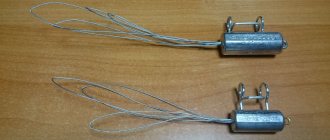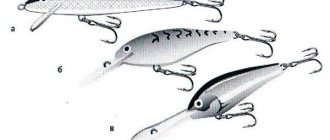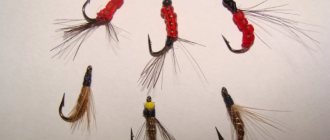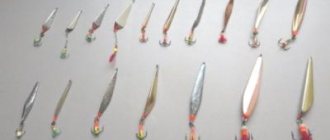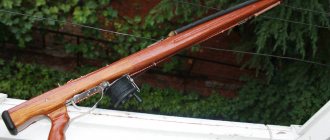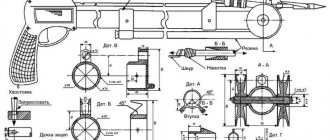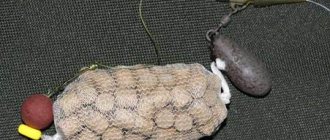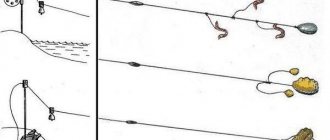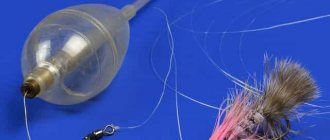Yuri 09/28/2020 1959
High-quality winter gear is not available to every fisherman. The bait often clings to snags or other underwater obstacles. A fishing hook will help you free caught gear and preserve an expensive and rare device. This accessory is effective in winter. Let's look at how the release works and whether it is possible to make it yourself.
Main characteristics of the device
The problem of gear catching on underwater obstacles is very common, and it occurs most often among beginners. Faced with unpleasant circumstances, they begin to pull the fishing rod with all their might, which only aggravates the situation and leads to the breakage of an expensive wobbler or spinner. With the help of a fishing release you can avoid unwanted losses and damage to your gear, but to do this you need to at least know how to use it.
The invention itself is a unique fishing accessory that effectively releases the bait from the hook, preventing it from breaking. At the same time, there is a wide variety of cuts that are intended for specific situations. There are also universal solutions on sale .
Operating principle of the accessory
The design of such a useful tool remains very simple, which allows it to quickly descend to the hook and without much effort retrieve a valuable wobbler or spinner. The operating principle is based on various auxiliary elements that allow you to get the bait from the depths.
Among the existing varieties, effective cats for fishing are in particular demand . They are a unique design made from a construction carabiner to which metal rings are attached. To pull out a wobbler with minimal risk of damage to the fishing line and the bait itself, you need to attach a “tee” or “double” to the release, as well as a strong thread.
Regardless of the design features, the releases have one goal - to successfully detach hooks from bottom obstacles. Heavy sinkers or rings can be used as auxiliary accessories, which lift the bait from the hook or provide reliable grip on the tackle. It is these elements that are the main component of such an accessory, because they have to be properly connected to the bait, and then pulled it to the surface. For the process to be successful, the unhooking tackle must be put on the main line and lowered at a certain degree to the location of the obstacle.
The moment of such a junction is felt in the form of vibrations of the fishing line and a stop in the unwinding of the rope or cord fixed on the release.
If the bait is still caught on a snag, stones or other bottom object, then this can be noticed when pulling the release to the surface, because when tightening the cord, a certain resistance will appear from the spinning wobbler or spoon. When working with the cord, you must be careful to avoid sudden and rapid jerks. Otherwise, this will lead to unpleasant consequences and cause damage to expensive gear.
There are several steps you can follow to achieve successful release.:
- Pulling.
- Vacation.
If the problem persists, try changing the location of the pull or the intensity of the twitching. Under no circumstances use too much force, as this will only damage the tees or cause a complete loss of the catchable bait.
Shore releases
Loop on the current
In some cases, a loop of fishing line will help, picking up the wobbler and freeing it from the snag under the influence of the force of the current.
With this procedure, you should refrain from strong jerks so that the hook does not go even deeper into the snag.
Cat release
One of the oldest and most popular coastal cut-offs. The “cat” itself is made of thick wire and tied to a strong cord. The success of the procedure largely depends on the accuracy of casting, which is carried out entirely manually.
Wire loop
It is better to have a simple wire loop in stock, mounted to an ordinary long stick. First, you need to pass the fishing line inside the loop, then lower the loop into the water, holding the stick by the other end. If possible, it doesn’t hurt to go into the pond a little to make the process of rescuing the bait easier.
floating ring
A detachment of this type can easily be made right on the spot if there are well-bending branches nearby (for example, willow branches). The simple design is a curved branch in the shape of a ring. The thickness of the branch is about 1.5-2 cm, length is 70-80 cm.
First, we clear the branch of bark and shoots, then we make a ring out of it, securing the ends with fishing line (you can use electrical tape instead of fishing line). First of all, you need to pass the fishing line through the release that goes to the bait.
The ring is thrown above the current and as far as possible from the hooking point. While swimming through the ring, you need to make sharp movements with the rod in order to pull out the bait.
Types of wobbler releases
How to make a hook with your own hands is a question faced not only by beginners, but also by more experienced fishermen. But before you develop drawings and start creating a homemade structure, you need to understand the existing varieties of such useful devices. If we are talking about boat and shore releases, then there are the following options:
- Tackle "Plumb".
- "Cat".
- "A noose on a stick."
- "Trap".
- "Floating Ring"
- Carbine trap.
Each variety has its own unique features, but the operating principle and basic design features are identical.
If we talk about the classic “Plumb” tackle, it is created on the basis of a cobble-shaped lead alloy weighing 20-50 g, which is equipped with two rings. The role of one is to fix the thick cord that pulls out the tackle, and the other is to pass the fishing line through the slot.
When the fishing line is pulled, the attached heavy tool plunges into the water column as quickly as possible and hits the bait, which causes it to detach. To successfully pull out, sometimes you have to repeat such actions several times, because sharp hooks can catch very strongly.
Experts recommend maintaining a certain angle of inclination of the release of 60-80 degrees relative to the main line. Sometimes direct impact of the load on the base of the bait also works effectively .
As for the “cat” release, it is a weighted structure based on a ring, which is equipped with retractable iron leads with “three points”.
Once in the right place, they literally bind to the hooks of the wobbler, and then release it after twitching the main cord. At the same time, the main line is not affected, so it remains safe and sound.
The “Loop on a Stick” tackle was invented a long time ago, and it served as a prototype for the manufacture of other homemade hooks. The design is very simple - a ring with a diameter of 3-4 centimeters is attached to a regular stick (it may be a different size, because it is selected in relation to the wobbler head).
After threading the ring through the main line, the stick is gradually lowered into the pond until the exact fixation of the release with the bait is found. Then all that remains is to smoothly lift the tackle to the surface, being careful.
Another unique tackle called “Trap” is also popular . It is made in the form of a triangular frame, which maintains real estate when lowered (causes the cord and main line to pass through). But when confronted with a hooked bait, the top of the foldable accessory folds, preventing the line from passing through the base.
Making a fishing hook
While studying the Polish experience of working with fishing gear and home-made products, I discovered new interesting home-made products for making detachments, or as they are called in the article, retrievers.
In Poland there is a fishing proverb that expresses the essence of fishing for a predator: “Gdzie patyki TAM wyniki”, which means “Where there are many underwater stumps, there are good fishing results.” As we know, fishing in such places is very dangerous for our bait, and we can easily lose it.
A long time ago, people realized this and began to invent hooks for bait - retrievers. If you ask the word “cut” in a search engine on the Internet, you can find many different designs of baits - retrievers. All of them can be considered effective under certain conditions.
After all, using expensive fishing gear, due to the lack of a release, a fisherman can lose his favorite fishing tackle, breaking the fishing line when he tries to forcefully pull out the bait. In this article I will bring to your attention several baits - retrievers.
You can easily make a release yourself with your own hands, and you will even enjoy it. Now let's see what these releases look like and how they work. So, we make our own tackle
Fishing hook from a socket wrench
1). The first release is the most effective and will never ruin your bait or treble hook. But it has one drawback, since it can only be used when you are directly above your bait.
Of course, this is not a problem when you are on a boat. The retriever saves the bait no less than 95%. How to do it? To do this, you will need a heavy steel rod or pipe with lead poured inside.
2). You can also, as in the photo shown, use a socket wrench filled with lead. This structure should weigh about 300-400g. The next step is to attach two very large rings made of wire with a diameter of about 3 mm, attach them to the pipe and pass the fishing line through the rings.
3) How to use the release? Same as in the photo below. As you move and remove your retriever along the line, it will quickly hit the hook or bait and release it. Sometimes it is necessary to release your lure at multiple angles and in different directions.
The second type is also very effective. We can use it when the bait is far from us - for example, when fishing for trout in a river. To use this method, you must use a rotation of the equipment.
The downside here is that your hook or treble will break, but when you're fishing with expensive rapalas or Japanese lures, I don't think it matters. I presented two working retrievers from recent work and took some photos.
I think they show quite well how to make this search engine. One important thing when used on fast rivers is to make the retrievers as thin and light as possible. Then it will be easier for you to reach your bait from a long distance.
In this case, the retriever must weigh from 100 grams to 250 grams. Using the proposed retrievers for a long time consistently shows good results. They all work well and keep not only my favorite baits, but also my wallet intact.
And now I want to offer you several videos of our craftsmen’s fishing hook in action. These releases are used in a vertical design. Spinning players, remember! Going fishing without unhooking is like buying fish in a store! Let's start with a set of uncoupling and attachments for it.
Unhook - the principle of operation for hitting when hooking a spinner, spoon and jig head
A release with a “Broom” attachment when hooking a wobbler
A detachment with a “Tee” attachment for hooking baits onto the net.
See you on the website Getting ready for fishing
Source: https://na-kruchok.ru/delaem-rybolovnyj-otcep
Efficient shore tools
The previous types of hooks are effective for boat fishing. For the shore, slightly modified products are used, including the “Floating Ring” tackle. If you want to make a detacher for spinners with your own hands, you need to pay due attention to this option, because despite its simple design, it copes with its duties excellently and retrieves bait even from the most inaccessible conditions.
It’s incredibly simple to create such tackle with your own hands - just find a twig and use it to make a ring with a diameter of 50-75 centimeters. Then the ring needs to be tightened around the main line of the fishing rod and securely fixed with any suitable material (adhesive tape, electrical tape), and then lowered into the water column. It is important not to forget to release the friction brake on the spinning reel at this stage.
Such a ring can change its direction, taking into account the strength of the current, which makes it effective for use on rivers.
Also popular is the so-called “carbine trap”, which is very easy to manufacture and just as easy to operate. It is enough to take a regular construction carabiner and attach a thick thread 10-15 centimeters long to it. In this case, metal threads equipped with tees or rings must be attached to the rim of the structure. With the help of tees, you can effectively hook onto the tees of a wobbler, pulling it out without damage.
An important feature: when equipping the releases with hooks, it is necessary to use slightly blunt models so that they do not create additional hooks when immersed in the water column.
How to use the device?
After the fisherman realizes that his balance beam is firmly stuck on some underwater obstacle, he should do the following:
- Take out the release and unwind the fishing line tied to it.
- Pull out the pin and insert the fishing line from the fishing rod into the slot.
- Push the pin inside.
- Pull the line from the fishing rod.
- Launch the release into the hole, you can even let it fall into free fall.
- Knock on the balancer until it is free from the hook.
Expert opinion
Knipovich Nikolai Mikhailovich
Zoologist, hydrobiologist. I am interested in fishing at a professional level.
Such actions help to save the balancer if it gets caught on a snag or stone. But only a powerful tee attached to the bottom of the cut will help you free yourself from abandoned nets. If the net is not too strong, then a piece of it with a balance beam stuck in it is pulled out onto the ice.
The balancer release is a fairly simple device that will help save the bait when this cannot be done in other ways.
Features of using gear
Depending on the type of cut, there are certain subtleties of its use. If we are talking about bulky and heavy models, then they are usually used from swimming equipment. Their impressive size and weight allow such devices to quickly and effectively repel the bait from an underwater obstacle, releasing it without any damage.
To successfully complete the procedure, you need to swim close to the spot and pull the line almost at a right angle to the bait, and then fix the release. Unlike many other types of uncouplings, in this case you have to use quick diving tactics.
The accessory should fall freely under the force of its own weight, literally hitting the obstacle and pulling out the wobbler . It will not be easy for a beginner to understand the principle of operation of such equipment, but in the learning process certain skills will be developed that will ensure a positive result.
If it so happens that the bait is caught directly near the shore, then you can tighten the main line and lower the unhooking device along it. While sliding along the fishing line, it will quickly reach the desired point, where auxiliary elements in the form of tees or metal chains will come into action.
Experts recommend using a strong cord that is attached to the release, because sometimes it has to cope with quite large loads.
For winter fishing
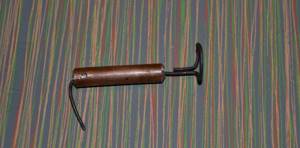
To make a release for winter fishing we will need:
- Lead (30-250g);
- Tube (5-10 cm, diameter depends on the desired weight of the cut);
- Wire (¤0.3cm, preferably rigid).
So let's get started. I think every fisherman is familiar with the technology of lead smelting.
Pour lead into the prepared tube. Before pouring, we can insert a nail inside the tube to create a hole. If you can't insert it, you can fill it with lead and then just drill a hole.
The next step is processing. We need to grind off all the burrs and irregularities.
After turning, insert the wire into our hole, as shown in the photo. Well, our DIY cut is ready
.
We tie the release to the fishing line 0.4-05
(the fishing line must be at least
10 m
), and into battle.
DIY making
And although fishing stores offer a wide variety of fishing hooks, if you have certain skills, available tools and desire, you can easily create such a device yourself at home. With the right approach, you can make cutters for spinners and wobblers with your own hands in 1 hour, reducing costs to a minimum.
So, during the manufacturing process you need to take:
- 1 meter of steel wire 0.5 mm thick.
- Pliers.
- 5 winding rings.
- Wire cutters.
- Powerful carbine.
- Drill.
- Chain.
- Cord.
- File.
The first step is to take a carabiner and place markings for drilling points on it. One point is placed at the top and the rest at the bottom. Then you should drill through holes, having previously treated the marks with the edge of a file to prevent excessive sliding of the drill.
Winding rings are threaded into the holes made, and a strong cord or rope is attached to one of them (the top one), which will be used in the pulling process.
Then you need to take a pre-prepared welded chain and divide it into equal length sections . The distance between them should be at least 8-10 centimeters.
The chain strips must be placed one by one on the winding rings of the carbine, and in order to give the release a more clustered appearance and prevent all the strips from accumulating in one place, another piece of chain is placed between them. As a fastening element, you should take a reliable wire, using it to secure the links at the joining points.
The principle of operation of such a product is very simple: the release is attached to the main line through a carabiner mechanism. After this, it slowly descends along the line directly to the bait through metal “tentacles” and hooks onto the tees. After manually pulling the release by the cord, the tackle is released.
Boat releases
Releases for spinners and wobblers that get stuck while fishing from a boat differ from shore ones in the complexity of manufacturing and use.
To release baits from the boat, they use a “cat” - a lead ring with tees attached to wire loops. The release is lowered towards the bait, and the tees of the wobbler engage with the winding link or hook. The fisherman can only pull it out with a little effort.
The breaker release is used to release bait when fishing on a boat or from ice. The main component of the device is a weight weighing 50-100 grams of any shape with a wire loop into which a fishing line or strong thread is passed.
The working line is threaded through a loop and lowered to the stuck tackle. Then they raise it to a height of up to 1 m and sharply lower it, creating a strong blow from above. Usually after several such strikes the hooks are released from the trap.
An effective but complex design is the trap release. The device consists of a droplet-shaped weight with a recess, to the bottom of which a wire loop is attached. An M-shaped rotating frame with a spring rests on the hinge. Using a cord, the release is lowered to the stuck bait. The frame opens, allowing the body of the wobbler to go inside, and rests against the hooked hook. As soon as the fisherman begins to pull the product up, a strong contact is formed between the tees of the wobbler and the frame, which allows it to be released.
